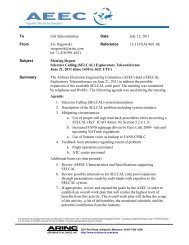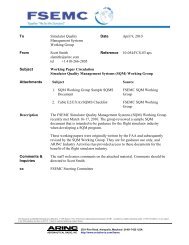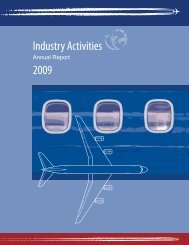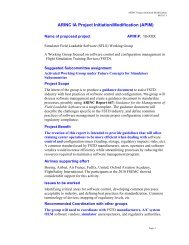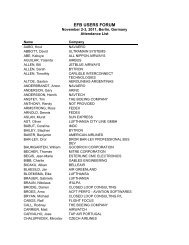(AGIE) Using Internet Protocols - Aviation Committees - AEEC - AMC
(AGIE) Using Internet Protocols - Aviation Committees - AEEC - AMC
(AGIE) Using Internet Protocols - Aviation Committees - AEEC - AMC
- No tags were found...
Create successful ePaper yourself
Turn your PDF publications into a flip-book with our unique Google optimized e-Paper software.
4.0 <strong>AGIE</strong> FUNCTIONAL SPECIFICATIONARINC PROJECT PAPER 830 – Page 35messaging). The basic components in an <strong>AGIE</strong> system are end user applications(technically considered not part of <strong>AGIE</strong> itself), <strong>AGIE</strong> clients, AMQP clients, <strong>AGIE</strong>servers, AMQP brokers, administrator (outside of <strong>AGIE</strong>) and network/networkmanager (outside of <strong>AGIE</strong>).At <strong>AGIE</strong> service level there are <strong>AGIE</strong> clients and <strong>AGIE</strong> servers, and at the AMQPlevel there are AMQP clients and AMQP brokers, respectively.<strong>AGIE</strong> servers and clients communicate at peer level as do AMQP clients andbrokers. <strong>AGIE</strong> clients and <strong>AGIE</strong> servers communicate vertically within the largerstack with AMQP brokers in one-to-one mapping. That is, each AMQP client isattached to an <strong>AGIE</strong> client and likewise each AMQP broker is attached to an <strong>AGIE</strong>server and there may be more than one AMQP broker attached to an <strong>AGIE</strong> server,as a distributed implementation of a single <strong>AGIE</strong> server. <strong>AGIE</strong> and AMQP clients aswell as <strong>AGIE</strong> and AMQP servers are considered co-resident. Detailed interfaces aredefined in Section 6.0.The relationships between these nodes are defined as either component-tocomponentwith functional interfaces or peer-to-peer with logical interfaces.Component interfaces are where <strong>AGIE</strong> components touch an adjacent component.These include: application-client, <strong>AGIE</strong> client-AMQP client, AMQP client-AMQPbroker, AMQP broker-AMQP broker, <strong>AGIE</strong> server- Network Manager, AMQP brokernetwork services, and <strong>AGIE</strong> server-Administrator.Peer level relationships are logical relationships to components at the same peerlevel. They are not adjacent components and communicate by coordinationmessages at <strong>AGIE</strong> service layer and built-in standard interfaces at AMQP layer.These relationships include: application-application, <strong>AGIE</strong> client-<strong>AGIE</strong> server, <strong>AGIE</strong> server-<strong>AGIE</strong> server.See interface definitions in Section 6 for interface details.4.2.6 <strong>AGIE</strong> Architectural Security<strong>AGIE</strong> has been architected to include secure messaging features. <strong>AGIE</strong> has built-infeatures designed for architectural security intended to provide domain segregationand allow sharing of datalinks between domains. <strong>AGIE</strong>’s client-broker architectureprovides an environment where inherent isolation exists between <strong>Internet</strong>-basedground clients and on-board clients with an <strong>AGIE</strong> server network in middle.1. Ground based clients have no direct visibility or addressing information foron-board clients (or any client, for that matter).2. <strong>AGIE</strong> server network is managed by airline IT therefore benefits from allavailable IT security capabilities.<strong>AGIE</strong> partitioning design provides for implementation of separate, secure physicallyand/or logically isolated messaging domains when necessary.1. Domain implementations and control is managed by the operator’s admin2. Naming and address is limited to nodes with “need-to-know” by the admin3. Private <strong>AGIE</strong> networks are defined by operator admin as isolated domainswith controlled inter-network communication tightly managed by the adminonly at the Primary ground server interconnect.



